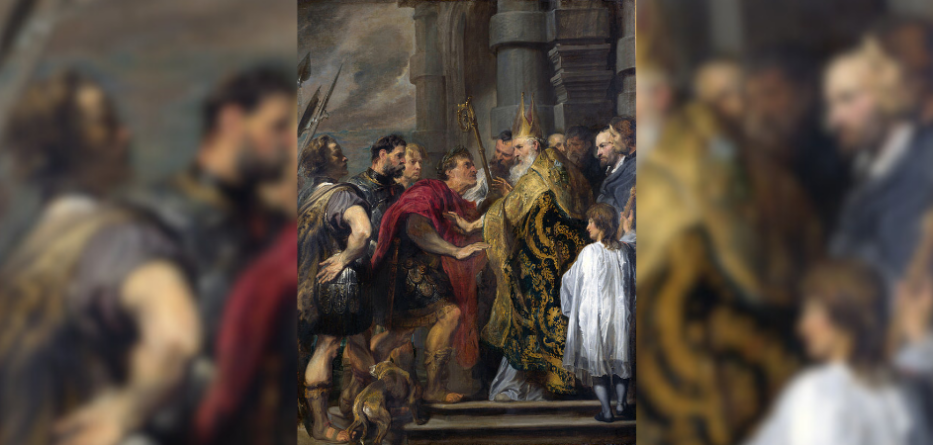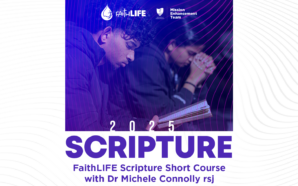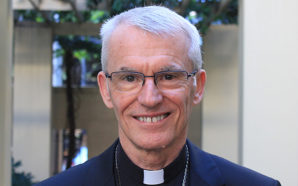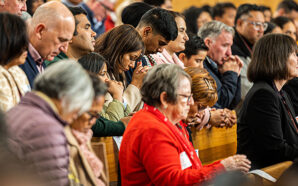Second Sunday of Advent
Readings: Baruch 5:1–9, Psalm 125 (126), Philippians 1:4–6, 8–11, Luke 3:1–6
8 December 2024
A voice cries in the wilderness. LK 3:4
Many years back, the popular musical, Godspell, though not always correct scripturally, contained in its theme song an essential prayer/truth: “Three things do I pray, dear Lord: to see thee more clearly, to love thee more dearly, to follow thee more nearly, day by day.” During Advent, we strive to see, love, and follow Jesus more each day, preparing to welcome him, not only at Christmas, but also when he returns to bring us home to himself. Today’s Gospel serves as a reminder that our own spiritual mountains of sin and pride can often hinder us.
Advent is the Church’s call to ask what those spiritual mountains are for me personally. None of us like to be confronted by this weaker, darker side of our human nature. We prefer to keep it hidden or pretend it doesn’t exist. (When was the last time I went to Confession?)
If fear or unworthiness prevents us from doing this, read St Paul’s words again: “The One who began this good work in you will see that it is finished when the Day of Christ Jesus comes” (Ph 1:6). We do not undertake this work of grace and renewal alone, or by our own power—God works in us, but we must open ourselves to the Holy Spirit and his grace for it to be effective. May we see, love and follow Jesus more in our lives, day by day, and be ready to welcome him at Christmas and when he comes again to call us home to himself.
Mary, Mother of the Word made flesh, pray for us. St Joseph, Guardian of the Redeemer, intercede for us. Amen.
Fr Christopher G. Sarkis
Artist Spotlight
The Emperor Theodosius is forbidden by Saint Ambrose to enter Milan Cathedral by Anthony Van Dyck (1599–1641).
The Emperor Theodosius is forbidden by Saint Ambrose to enter Milan Cathedral (c. 1619–1620). Oil on canvas, 149cm × 113.2 cm. The National Gallery, England. Public Domain.
No one was more surprised that he became bishop of Milan than Ambrose himself. He had been born in A.D. 339, the son of the prefect of Gaul. When his father died, the family returned to Rome. Ambrose then began a study of Greek, rhetoric, and poetry, becoming a successful advocate at law. His extraordinary ability attracted the attention of the emperor who appointed him governor of Northern Italy when he was only 33. When the bishop
of Milan died, Ambrose attended the assembly convoked to elect his successor. During his speech appealing for peace, a voice, often said to be that of a child, cried out: “Ambrose for bishop!” To his astonishment, the whole crowd took up the slogan. In vain, he pleaded his unsuitability—he was still a catechumen and unbaptised! Within a week he had received the sacraments and was consecrated bishop on 7 December 374.
An immediate conversion began. Ambrose gave all his personal property to the poor, and his lands to the Church. He plunged himself into the study of Scripture and the Church Fathers. He explained that he had to both learn and teach at the same time.
He soon became famous for his practical and bold sermons. As Augustine—his most famous convert— put it: “[Ambrose spoke] well, judiciously, to the point, and with power of expression.” We know Ambrose now as one of the four great Latin doctors of the Church with Augustine, Jerome and Gregory the Great.
Ambrose lived a penitential life, taking food very sparingly. Throughout the day, he was at the disposal of all, both high and low. His night hours were devoted to correspondence and the writing of his books. He defined the position of the Church— its authority to teach morals and govern itself. Ambrose was a well-known writer of hymns. The old Divine Office contained 14 of them, gems of religious poetry. He encouraged the monastic life, and strongly recommended Our Lady as the patron and model of nuns.
On this last point, we can take Ambrose as one of our models for Advent. Commentating on the Gospel scene of the Visitation, Ambrose applies Elizabeth’s words to each individual believer. “You, too, are blessed because you have heard and believed. The soul of every believer conceives and brings forth the Word of God and recognises his works. Let Mary’s soul be in each of you to glorify the Lord. Let her spirit be in each of you to rejoice in the Lord” (St Luke’s Gospel, Lib. 2).
This theme would be taken up by Ambrose’ disciple, Augustine, who wrote that Mary’s greatness lies not so much because she is Christ’s mother, but because she is Christ’s disciple. We cannot be Christ’s mother in the flesh, he said, but we can be Christ’s mother when we bring him to birth in the hearts of others (cf. De Sancta Virginitate).
Ambrose’s feast, occurring yesterday (7 December), is a fitting prelude to tomorrow’s Immaculate Conception—Mary being, as the poet William Woodsworth put it, “Our tainted nature’s solitary boast” (The Virgin, 1822).
Ambrose died before he was 60. His body has rested under the high altar of his basilica in Milan since 835. He had a great effect on two of his successors, now canonized saints: Charles Borromeo, and Cardinal Giovanni Battista Montini who became Pope Paul VI.
Born in Antwerp in 1599 to a wealthy silk merchant, Anthony Van Dyck began working in the studio of renowned painter Peter Paul Rubens at the young age of 19. Rubens became a significant influence on Van Dyck’s work. Alongside Diego Velasquez, Van Dyck transformed the art of painting court portraits. His talent was quickly recognised in England, where he was eventually knighted by Charles I. Van Dyck passed away in 1641 in England and was laid to rest in the choir of St Paul’s Cathedral. Unfortunately, his tomb was destroyed during the Great Fire of London in 1666.
In the painting we are contemplating today, Emperor Theodosius is depicted being prevented from entering Milan Cathedral by the bishop, St Ambrose, as a response to Theodosius’ massacre of the people of Thessalonica. The emperor is accompanied by three soldiers, with the soldier on the left being the arrogant Ruffinus. St Ambrose famously declared to Ruffinus: “Thou hast no more shame than a hound,” as a dog sits at the soldier’s feet. The saint’s gaze is focused on Ruffinus rather than Theodosius.
Monsignor Graham Schmitzer
Fr Christopher G Sarkis is the parish priest of Our Lady Help of Christians Parish in Rosemeadow, NSW. Ordained in 1985, he has served in various parishes in the Diocese of Wollongong. His current diocesan roles include the College of Consultors, Council of Priests, and Clergy Remuneration Fund.
Monsignor Graham Schmitzer, retired parish priest of Immaculate Conception Parish in Unanderra, NSW, was ordained in 1969 and served in many parishes in the Diocese of Wollongong. He was chancellor and secretary to Bishop William Murray for 13 years. Raised in Port Macquarie and educated by the Sisters of St Joseph of Lochinvar, he worked for the Department of Attorney General and Justice before entering St Columba’s College in 1962. He enjoys travelling and visiting major European art galleries.
With thanks to the Diocese of Wollongong, who have supplied this reflection from their publication, The Light: Advent and Christmas Daily Reflections 2024. Reproduced with permission.








